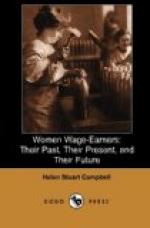“Women were hindered at every turn by endless restraint in endless minor detail of habit, custom, tradition, etc.... Most women who have been engaged in any new departure would testify that the difficulties of the undertaking lay far more in these artificial hindrances and burdens than in their own health, or in the nature of the work itself.”
It was this shrinking from publicity, among all save the most ordinary workers, by this time largely foreign, that made one difficulty in the way of census enumerators. By 1860 it had become plain that an enormous increase in their numbers was taking place, and that no just idea of this increase could be formed so long as industrial statistics were made up with no distinction as to sex. The spread of the factory system and the constant invention of new machinery had long ago removed from homes the few branches of the work that could be carried on within them. Processes had divided and subdivided. The mill-worker knew no longer every phase of the work implied in the production of her web, but became more and more a part of the machine itself. This was especially true of all textile industries,—cotton or woollen, with their many ramifications,—and becomes more so with each year of progress.
Cotton and woollen manufactures, with the constantly increasing subdivisions of all the processes involved, counted their thousands upon thousands of women workers. Another industry had been one of the first opened to women, much of its work being done at home. Shoemaking, with all its processes of binding and finishing, had its origin for this country in Massachusetts, to the ingenuity and enterprise of whose mechanics is due the fact that the United States has attained the highest perfection in this branch. Lynn, Mass., as far back as 1750, had become famous for its women’s shoes, the making of which was carried on in the families of the manufacturers. At first no especial skill was shown; but in 1750 a Welsh shoemaker, named John Adam Dagyr, settled there and acquired great fame for himself and the town for his superior workmanship. In 1788 the exports of women’s shoes from Lynn were one hundred thousand pairs, while in 1795 over three hundred thousand pairs were sent out, and by 1870 the number had reached eleven million.
Beginning with the employment of a few dozen women, twenty other towns took up the same industry, and furnish their quota of the general return. The Massachusetts Bureau of Labor gives, in its report for 1873, the number of women employed as 11,193, with some six hundred female children. Maine and New Hampshire followed, and both have a small proportion of women workers engaged in the industry, while it has gradually extended, New England always retaining the lead, till New York, Philadelphia, and many Western and Southern towns rank high in the list of producers.




